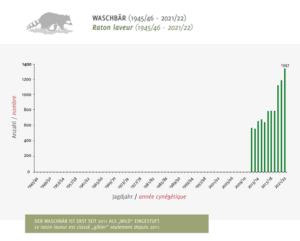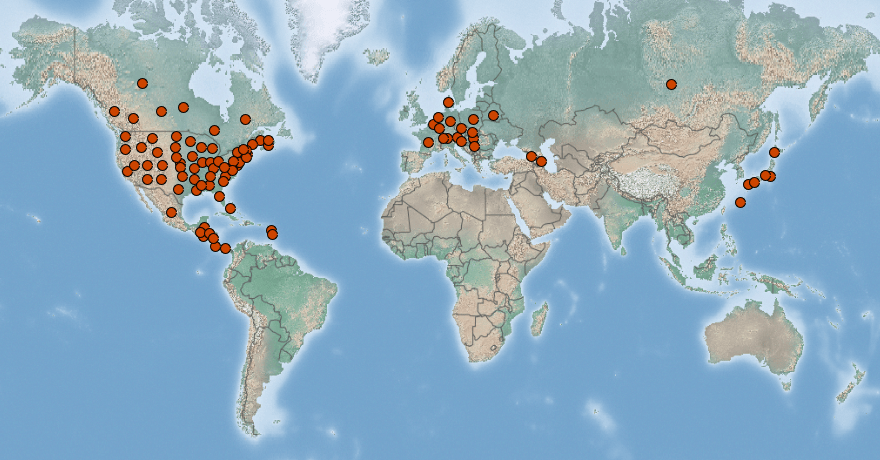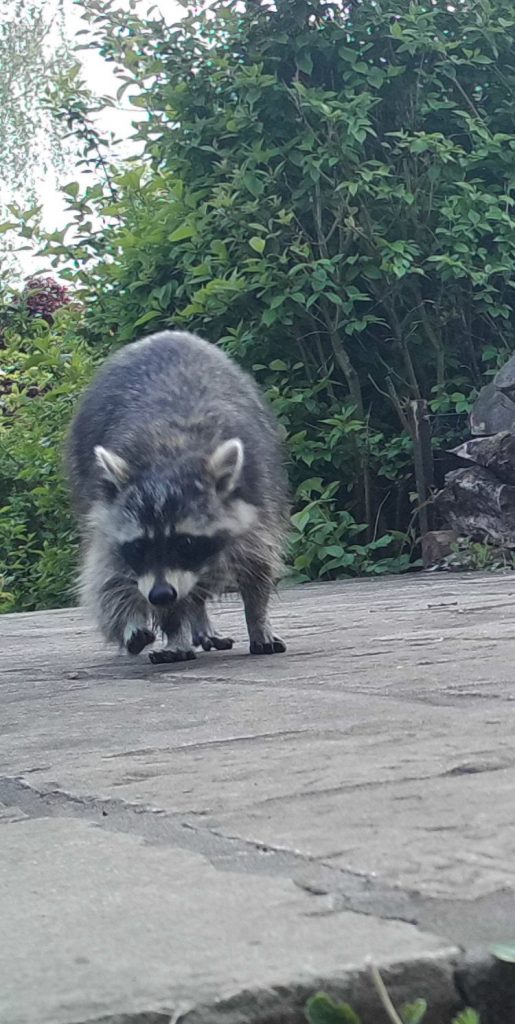 |
Raccoon | Status LU: established.1st record: 1979. |
 |
Wäschbier | Status Eur.: established. IAS of EU concern (2016). |
 |
Raton laveur | RA: ISEIA: C3. Harmonia+: 0,33 |
 |
Waschbär | Wikipedia:     | Wikispecies: | Wikispecies:  | CABI | CABI |
 |
Gewone wasbeer | Back to the list of vertebrates |
Contents
Report the species
→ Report Procyon lotor to the National Museum of Natural History.
Brief description
Procyon lotor (Linnaeus, 1758) shows a preference for wetlands and old deciduous forests with hollow trees, often adjacent to water. The species is, however, able to adapt to a high diversity of environmental conditions, including urbanized areas. There is little evidence (but strong suspicion) of species displacement/extinction through predation or interspecific competition by raccoons in Western Europe. Food is often gathered on rubbish dumps or from bins, where the animal can be a nuisance to people. Raccoons are vectors for several diseases, including rabies. The raccoon is included in the appendix under recommendation no.77 of the Council of Europe as a species which has proved to be a threat to biological diversity and for which eradication is strongly recommended (Branquart et al. 2009).
Due to its very pronounced sense of touch, the raccoon can grab the smallest prey with its front paws. Since this often happens in the shallow water of small streams, it looks like it is washing its prey. This behaviour has given the raccoon its name in some languages, e.g. in German “Waschbär” and in French “raton laveur” (Schley & Herr 2019: 65).
IAS of Union concern
In 2016, Procyon lotor (Linnaeus, 1758) was added to the list of invasive alien species of Union concern (Anonymous 2016) which implies that member states shall take all necessary steps to prevent it’s unintentional introduction or spread.
Status and distribution in Luxembourg
Records of Procyon lotor Linnaeus, 1758 in Luxembourg. Data source: Recorder-Lux, iNaturalist & GBIF, 2025-07-06.
Procyon lotor (Linnaeus, 1758) is probably present in Luxembourg since the 1970s, mainly in the Oesling area (Becker-Krüll & Schaefer 2013). The first record in Luxembourg dates from 1979 (Pelt 1979; Schley & Herr 2019: 64). The first observation documented in the Recorder-Lux database dates from 1989 and was found in Munshausen, Municipality of Clervaux (MNHNL 2000-).
In the last few years, different cases of people keeping raccoons as illegal pets became public in Luxembourg. In August 2024, the Ministry of Agriculture, Food and Viticulture and the Ministry of Health and Social Security issued a common press release informing about the potential presence of the raccoon roundworm (Baylisascaris procyonis) within the local raccoon population and the risks associated with that parasite.
Management
Action plan
An action plan concerning the racoon has been published in 2020:
→ Finalised Action Plan for Procyon lotor (De Sousa 2020)
Raccoon hunt in Luxembourg
The raccoon is considered a game animal in Luxembourg since 2011.

Development of the number of raccoons shot since their inclusion in the hunting list in 2011 (Jacobs & Schley 2022)
600 to 700 animals have been shot per hunting season between 2011 and 2013 (Schley et al. 2014: 25). The numbers increased in the following years to reach 900 shot raccoons in the hunting season 2017-2018 (Schley & Cellina 2018: 11) and 1.347 in 2021-2022 (Jacobs & Schley 2022). The geographical distribution of shot raccoons is in line with the raccoon distribution based on data from Recorder-Lux, GBIF and iNaturalist (MNHNL, iNaturalist & GBIF 2024). In 2021 the estimated population was around 20.000 individuals (Tiago de Sousa in Adami 2022: 5).
Risk assessment
ISEIA protocol
C3 (3+2+2+1) (Ries et al. 2014: 199).
Harmonia+ protocol
Overall risk score 0,33 = (Overall Invasion score 0,56 x Overall Impact score 0,58) (evaluated by Sandra Cellina, Roland Proess and Jan Herr).
 Invasion
Invasion0,58

 Impact
Impact0,33

 Risk
RiskWorldwide distribution

CABI 2009: https://www.cabi.org/isc/datasheet/67856#toDistributionMaps
Fact sheet
PDF fact sheet of the Nature and Forestry Administration: FR | DE
Bibliography
- Adami, J., 2022. Invasive Tierarten: Achtung, Problembärchen. woxx n°1673: 4-5 (2022-02-25).
- Anonymous, 2016. Commission implementing regulation (EU) 2016/1141 of 13 July 2016 adopting a list of invasive alien species of Union concern pursuant to Regulation (EU) No 1143/2014 of the European Parliament and of the Council. Official Journal of the European Union L 189: 4-5.
- Becker-Krüll, L. & P. Schaefer, 2013. Jagdbare Wildtierarten Luxemburgs. 96 pp. 1. Aufl. Hrsg. Naturverwaltung Luxemburg. (Order or download PDF)
- Branquart, E., M. D’aes, B. Manet, G. Motte, V. Schockert & J. Stuyck, 2009. Harmonia database: Procyon lotor (Linnaeus, 1758). Harmonia version 1.2, Belgian Forum on Invasive Species. URL: http://ias.biodiversity.be [accessed on 2019-11-26]
- CABI, 2009. Procyon lotor (Linnaeus, 1758) [original text by Stanley Gehrt]. In: Invasive Species Compendium. Wallingford, UK: CAB International. URL: www.cabi.org/isc [accessed 2019-11-26]
- De Sousa, T., 2020. Plan d’action pour espèces exotiques envahissantes au Grand-Duché de Luxembourg: le Raton laveur, Procyon lotor (Linnaeus, 1758). Version 2020-09-04. Administration de la nature et des forêts, Luxembourg. 23 pp.
- Jacobs, M. & L. Schley, 2022. Bulletin technique de l’Administration de la nature et des forêts en matière de gestion de la faune sauvage et de chasse, numéro 9 (2022) 72 pages.
- Kirsch, E., K. Klein, L. Bonblet, M. Weishaar, T. Duscher, T. De Sousa & M. Jacobs, 2021. Waschbären & Marderhunde in Luxemburg. 48 S. Hrsg.: Administration de la nature et des forêts (ANF) & Musée national d’histoire naturelle (MNHNL). [PDF >5 MB]
- Kosik-Bogacka, D., N. Osten-Sacken, N. Łanocha-Arendarczyk, K. Kot, B. Pilarczyk, A. Tomza-Marciniak, J. Podlasińska, M. Chmielarz & M. Heddergott, A.C. Frantz, P. Steinbach, 2019. Selenium and mercury in the hair of raccoons (Procyon lotor) and European wildcats (Felis s. silvestris) from Germany and Luxembourg. Ecotoxicology https://doi.org/10.1007/s10646-019-02120-3
- MNHNL, 2000-. Procyon lotor (Linnaeus, 1758) in Recorder-Lux, database on the natural heritage of the Grand Duchy of Luxembourg. Musée national d’histoire naturelle, Luxembourg. URL: https://mdata.mnhn.lu [Accessed 2020-02-04]
- MNHNL, iNaturalist & GBIF, 2020. Procyon lotor (Linnaeus, 1758) in MNHNL-mdata, online portal combining species observation from Recorder-Lux, iNaturalist and GBIF. National Museum of Natural History, Luxembourg. URL: https://mdata.mnhn.lu [Accessed 2020-02-04]
- Pelt, J., 1979. Ein überraschendes Jagderlebnis. De lëtzebuerger Jéer 3/79: 23.
- Pir, J.B. & L. Schley, 2015. Développement des connaissances sur la répartition et l’écologie des mammifères au Luxembourg entre 1990 et 2015. Bull. Soc. Nat. luxemb. 116: 437-455. [PDF 2,04 MB]
- Ries, C., M. Pfeiffenschneider, Engel, E., J.-C. Heidt & M. Lauff, 2014. Environmental impact assessment and black, watch and alert list classification after the ISEIA Protocol of vertebrates in Luxembourg. Bull. Soc. Nat. luxemb. 115: 195-201. [PDF 247 KB]
- Schley, L. & J. Herr, 2019. Säugetiere Luxemburgs. Hrsg.: natur&ëmwelt a.s.b.l., Ministère du développement durable et des infrastructures, Administration de la nature et des forêts. 219 S. ISBN 978-2-9199511-0-9 [French edition: Les mammifères du Luxembourg, ISBN 978-2-9199511-2-3]
- Schley, L., C. Schanck, M. Schaul & C. Sinner, 2001. Neubürger und Heimkehrer unter den Wildtieren Luxemburgs. Beiträge zur Jagd- und Wildforschung 26: 141-154.
- Schley, L., R. Reding & S. Cellina, 2014. Bulletin technique de l’Administration de la nature et des forêts en matière de gestion de la faune sauvage et de chasse, n° 3, 72 pp. (Order or download PDF)
- Schley, L. & S. Cellina, 2018. Technischer Bericht der Naturverwaltung betreffend Wildtiermanagement und Jagd, Nr. 7, 52 S. Administration de la nature et des forêts, Diekirch. [PDF 13 MB]
Suggested citation of this webpage
Ries, C. & M. Pfeiffenschneider (Eds.), 2025. Procyon lotor (Linnaeus, 1758). In: neobiota.lu - Invasive Alien Species in Luxembourg. National Museum of Natural History, Luxembourg. URL: https://neobiota.lu/procyon-lotor/ [Accessed 2025-07-06].
Page content last updated on 2024-08-07. Last proofread by Caroline Grounds on 2019-11-28.


